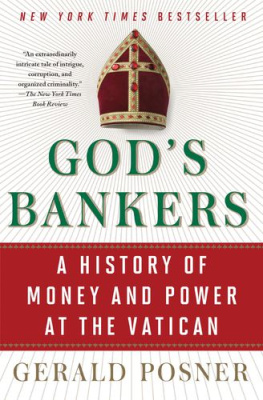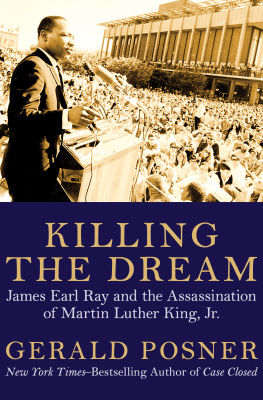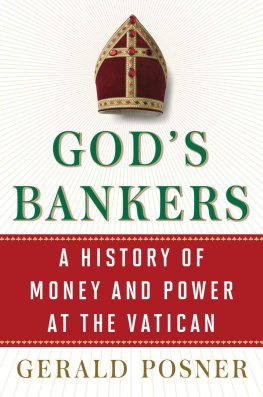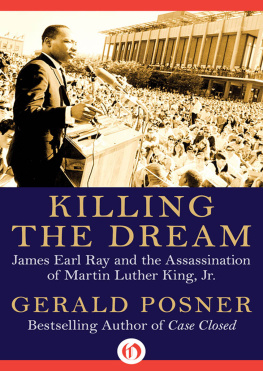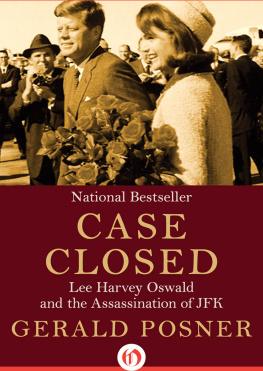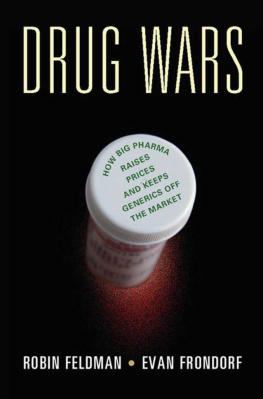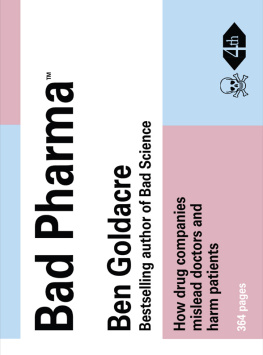Contents
Guide
ALSO BY GERALD POSNER
Gods Bankers
Miami Babylon
Secrets of the Kingdom
Why America Slept
Motown
Killing the Dream
Citizen Perot
Case Closed
Hitlers Children
The Bio-Assassins
Warlords of Crime
Mengele
A VID R EADER P RESS
An Imprint of Simon & Schuster, Inc.
1230 Avenue of the Americas
New York, NY 10020
www.SimonandSchuster.com
Copyright 2020 by Area 51 LLC
All rights reserved, including the right to reproduce this book or portions thereof in any form whatsoever. For information, address Avid Reader Press Subsidiary Rights Department, 1230 Avenue of the Americas, New York, NY 10020.
First Avid Reader Press hardcover edition March 2020
AVID READER PRESS and colophon are trademarks of Simon & Schuster, Inc.
For information about special discounts for bulk purchases, please contact Simon & Schuster Special Sales at 1-866-506-1949 or .
The Simon & Schuster Speakers Bureau can bring authors to your live event. For more information or to book an event, contact the Simon & Schuster Speakers Bureau at 1-866-248-3049 or visit our website at www.simonspeakers.com.
Jacket design by Alex Merto
Author photograph Dale Stine
Library of Congress Cataloging-in-Publication Data is available.
ISBN 978-1-5011-5189-7
ISBN 978-1-5011-5204-7 (ebook)
To Trisha, my muse and eternal love, all things are possible only with you
PREFACE
James Phelan, a legendary reporter, gave me the idea for a book about the pharmaceutical industry over twenty years ago. In the 1990s, Phelan, an old-fashioned shoe-leather reporter, and I shared the same book editor, Robert Loomis. Phelan had a deserved reputation for cracking big cases. The New York Times had dubbed him one of the countrys finest investigative journalists. Unmasking Clifford Irvings autobiography of Howard Hughes as a hoax was his biggest scoop.
I had met Phelan while researching Case Closed, my reinvestigation of the JFK assassination. In the late 1960s his groundbreaking reporting exposed that New Orleans district attorney Jim Garrison had falsified evidence in his criminal probe of whether there was a Big Easy conspiracy link to the assassination.
In the summer of 1997, I called him for some advice on my examination of the Martin Luther King Jr. assassination. We also talked about the state of investigative journalism. Phelan, not someone I knew to indulge in nostalgia, reminisced that he thought it had changed mostly for the worse. The trend toward ever-shorter deadlines made it tougher, he thought, to undertake long-term investigations. Even good reporters might return after a few months without a breakthrough. He cited examples from his own reporting, including one when military investigators had coerced a fake murder confession from an Air Force officer and another in which a California chiropractor had fleeced millions from patients with a bogus cure. There was no certainty when he got those assignments that he would crack the story. The tips and strands of evidence that initially caught his attention might have turned into dead ends.
Thats a risk that most magazine and newspaper editors no longer want to take, he said. You can at least still do it in books, there you have the time and space to get to the bottom of a good story.
He did not hesitate when I asked what subject he still considered challenging for a book.
The pharmaceutical business. Its like throwing a dart at a storyboard.
Phelan said he was too old at eighty-five to undertake such a large project. He did not tell me he was also too sick. A few months later I learned he had died of lung cancer. Our last conversation planted in me the idea of one day looking into a book about the drug industry. In publishing, however, even good ideas can take years before they come to fruition.
It was January 2016 when I sent my editor, Ben Loehnen, a proposal with the no-frills working title A History of the American Pharmaceutical Industry. I had read by then several dozen good books, each about some part of the story I hoped to cover in its entirety. There were histories of epidemics and pandemics, inspiring accounts of groundbreaking lab discoveries, biographies of storied scientists and pharma executives, even business histories of some companies. There was, however, no single volume that started with the wild anything-goes nineteenth-century era of homegrown wonder remedies to todays sprawling pharma conglomerates that sell a trillion dollars of drugs annually.
When I sent that proposal to Ben, I had not started my research in earnest. A proposal is sometimes not much more than selecting the books topic. The finished manuscript might be radically different. Pharma proved to be a classic investigative story. Few will be surprised that a significant obstacle was the drug industrys zealous protection of its secrets. That forced me to find drug executives, scientists, and government regulators who were willing to talk, some of whom had never spoken on the record. Others, fearing retribution from their employers or the industry itself, agreed to help only on the condition of anonymity. Besides those interviews, uncovering the information at the heart of this book required sifting through tens of thousands of pages of overlooked government regulatory documents, hunting for evidence buried in the exhibits of massive pharmaceutical litigation, and examining remote and seldom accessed private archives.
I did not expect to find one person or a single family who provided a narrative thread through which to examine the industrys explosive growth after World War II. It was in those seventy postwar years that pharma transformed into a mega-industry.
The Lilly family, as well as the Mercks, Squibbs, and Johnsons, had left the industry as their companies became massive conglomerates. The term Big Pharma appeared first in news articles during the 1960s to describe a handful of dominant firms. New titans arrived, but much later during the biotechnology revolution. I had always intended to write a chapter about three brothers, Arthur, Mortimer, and Raymond Sackler. They are best known today for buying in 1952 a small drug company, Purdue, that started manufacturing the opioid painkiller OxyContin in 1996.
During my research I discovered they played a much more extensive role in the drug business, often at critical junctures, starting in the 1940s. A largely unknown backstory of the Sacklers came alive in interviews and never-before-seen documents. In response to my Freedom of Information requests, FBI declassified files revealed the extent of the Sackler familys radical left-wing politics and the Bureaus suspicions about their loyalty to America. Notes and memos from a 1962 Senate committee had the details of what the investigative staff had uncovered about a hidden Sackler empire. And, in late 2018, a small treasure trove of documents arrived at my office. They were in a sealed, plain manila envelope postmarked from New York and without a return address. Inside were copies of FDA and DEA documents with answers to some long-standing questions about how the Sacklers rose to such tremendous power and wealth.
Pharma opens a rare insiders window on the internecine battles between scientists and executives over drugs and money. It is about the secret world inside companies that are household names and how the quest for blockbuster drugs has at times crippled and distorted the industrys original mission to develop medications that treat the sick and save lives.

